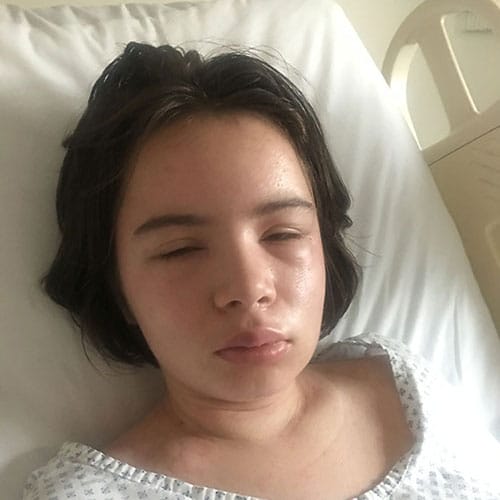*Note from A Chronic Voice: Julia is passionate about writing and contributes to various online publications. She aims to raise awareness on rare diseases and mental health, and we’re honoured to have her share her story with us here today. The stress of living with either chronic illness, permanent injury, or mental illness is one that must be carefully watched, as they can easily feed into each other and create yet more problems. Let’s begin with Julia’s story, starting out in Mexico…
Table of Contents
A Strange Awakening
The day after my twentieth birthday, I woke up covered in hives and my face was swollen beyond recognition. I had experienced a myriad of mysterious symptoms after being in a car accident when I was eighteen and a half – including severe pain, anaphylaxis, and nausea. I knew I was sick, but despite nearly weekly doctor’s appointments for over a year, no one was able to pinpoint what was wrong.
It soon became clear that I had to go to the hospital. Soon after I arrived, I was moved from the Emergency Room to an inpatient area, and doctors tried their best to stabilize my symptoms. For some reason, having to be on oxygen, as my levels were in the 70s, didn’t freak me out, as it would a few years prior. Instead, what really scared me was seeing a photo of my face.
The Distress of Not Recognising Your Own Face
I happened to be in Mexico when this attack started. I’m covered by American insurance which requires ‘evidence’ to cover out of country medical emergencies. Even though I would later receive documentation that would confirm this from the hospital, my dad thought it would be a good idea to take photos of my appearance.
I agreed to this, not realizing that I looked drastically different – in my opinion, worse – than I did when I had looked in a mirror before going to the hospital. When my dad showed me the photo on his phone, I audibly shrieked. I didn’t recognize the person in the photo. My eyes looked like they were swollen shut, despite being open, and the rest of my face was extremely puffy.

Julia then…

…and now.
Developing a New Mental Disorder Post-Diagnosis
A little over a week later, I was discharged and given a diagnosis, pending the confirmation of a biopsy, of systemic urticarial vasculitis. That period when I was in the hospital was the longest of my life. At times, I wasn’t sure that I would make it – but I pulled through. What I didn’t know at the time was that I had developed body dysmorphic disorder as well. Body dysmorphic disorder, according to the Mayo Clinic, is a “mental disorder in which you can’t stop thinking about one or more perceived defects or flaws in your appearance.”
My journey with figuring out which autoimmune disease was making me sick – and being told that my symptoms were ‘in my head’ – had already taken a toll on my mental health. Shortly before I was hospitalized in Mexico, I had just left my university due to symptoms impacting my ability to study, which led to me feeling severely anxious and depressed. I thought this was characteristic of anyone who developed a chronic illness.
Unfortunately, this led to me to ignore certain behaviors that I expressed after this severe flare up that were warning signs that I had developed body dysmorphic disorder. After getting home, I found myself staring photos of myself and in the mirror much more often. I didn’t do so out of any superficial reason – I was genuinely convinced that if I caught any physical signs of my vasculitis, I could prevent myself from having a severe flare. But, I would convince myself that I was on the verge of an attack and needed to go to the hospital immediately because of ‘physical signs’ of my vasculitis. In reality, I probably just had some pimples, not hives.
A Vicious Cycle and Getting Help
While this behavior was unhealthy for me mentally, the stress took a toll on my body. Like with many chronic illnesses, anxiety aggravates vasculitis. I became somewhat obsessed with my appearance. My anxiety, which has always been terrible, had gotten even worse. I genuinely did have flare ups from my vasculitis, but this could have been triggered in part from my fear of getting flare ups. After talking to my rheumatologist about my anxiety, she referred me to a psychologist who treats many chronic illness patients.
This psychologist diagnosed me with body dysmorphic disorder. And, just with my vasculitis diagnosis, I had to work to get better. I’m still working on getting better. I specifically was and continued to be treated in cognitive behavioral therapy (CBT). Just like with my autoimmune disorder, my mental health issues won’t go away – I just need to work to manage them.
How I Cope with Body Dysmorphic Disorder Every Day
As someone who has body dysmorphic disorder, I have a few suggestions for coping with it. Here are a few of them. My first one is to recognize that some of your behavior and thoughts about your appearance may be irrational. My fear that I would have a severe vasculitis flare up again was rational, but my behavior in obsessing over my appearance was not. My second is to work to change it. This may be different for everyone, but, if you’re like me, CBT can help.
It’s been over a year since my hospital stay in Mexico, and I’m doing a bit bit better – both physically and mentally. I can look at a selfie of myself without worrying myself sick, but I often need to catch myself when I see a pimple. Vasculitis and body dysmorphic disorder were both unexpected surprises in my life – but I’m strong, and I’ll pull through.
*Note: This article is meant for educational purposes and is based on the author’s personal experiences. It is not to be substituted for medical advice. Please consult your own doctor before changing or adding any new treatment protocols.
Read More: Yes, You are Allowed to Feel Upset
If you liked this article, sign up for our mailing list so you don’t miss out on our latest posts! You will also receive an e-book full of uplifting messages, quotes and illustrations, as a token of appreciation!



Contributor Bio



